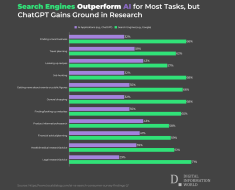Artificial Intelligence (AI) has become an integral part of our daily lives, providing answers to our questions with remarkable speed and accuracy. However, it’s essential to critically evaluate and verify the information received from AI to ensure its reliability. This article will guide you through strategies for fact-checking AI-generated answers, helping you become a more informed and discerning user when asking AI questions.
Understanding AI Limitations


Before diving into fact-checking strategies, it’s crucial to understand that AI, despite its advanced capabilities, has limitations. AI models are trained on vast datasets, but they can still produce incorrect or biased information. Recognizing these limitations is the first step in critically evaluating AI-generated answers.
Cross-Referencing Information
One of the most effective ways to verify AI-generated answers is by cross-referencing the information with multiple reliable sources. For example, if an AI provides a historical fact, check reputable history websites or academic publications to confirm its accuracy. Cross-referencing helps ensure that the information is consistent and trustworthy.
Checking the Source When Asking AI Questions
When asking AI questions, always consider the source of the information. AI models often provide references or sources for their answers. Verify these sources to ensure they are credible and authoritative. For instance, if an AI cites a scientific study, look up the study to confirm its validity and relevance.
Evaluating the Context
Context is key when evaluating AI-generated answers. Sometimes, AI may provide accurate information, but it might be taken out of context. Ensure that the information fits the context of your query. For example, if you’re asking about a medical condition, make sure the AI’s response is relevant to your specific situation.
Using Fact-Checking Websites


Several fact-checking websites, such as Snopes, FactCheck.org, and PolitiFact, can help verify the accuracy of AI-generated answers. These websites specialize in debunking false information and can be valuable resources for cross-referencing AI responses.
Consulting Experts
When in doubt, consult experts in the relevant field. If an AI provides information on a complex topic, such as legal advice or medical recommendations, it’s always a good idea to seek confirmation from a qualified professional. Experts can provide nuanced insights and verify the accuracy of the AI’s response.
Analyzing the Language
Pay attention to the language used by the AI. If the answer contains vague or ambiguous terms, it might indicate a lack of confidence in the information provided. AI models often use qualifiers like “might,” “could,” or “possibly” when they are uncertain. Be cautious with such responses and seek additional verification.
Recognizing Bias
AI models can inadvertently reflect biases present in their training data. Be aware of potential biases in AI-generated answers, especially on sensitive topics like politics, race, or gender. Cross-referencing information from diverse sources can help identify and mitigate bias.
Staying Updated
AI models are continually evolving, and their accuracy improves over time. Stay updated with the latest developments in AI technology and fact-checking methods. Following reputable AI research organizations and publications can help you stay informed about advancements and best practices.
Practical Example: Verifying AI-Generated Answers


Let’s consider a practical example. Suppose you ask an AI about the benefits of a particular diet. The AI provides a detailed response, citing various studies and expert opinions. To verify this information, you can:
- Cross-Reference: Check the cited studies on reputable nutrition websites or academic journals.
- Check the Source: Ensure the studies are published in credible journals and authored by qualified researchers.
- Evaluate the Context: Make sure the AI’s response is relevant to your dietary needs and health conditions.
- Consult Experts: Seek advice from a registered dietitian or nutritionist to confirm the AI’s recommendations.
By following these steps, you can confidently verify the accuracy of AI-generated answers and make informed decisions.
Conclusion
Asking AI questions can be incredibly useful, but it’s essential to approach the information with a critical mindset. By cross-referencing information, checking sources, evaluating context, using fact-checking websites, consulting experts, analyzing language, recognizing bias, and staying updated, you can effectively verify the accuracy of AI-generated answers. Remember, the goal is to become a more informed and discerning user, ensuring that the information you receive is reliable and trustworthy.
Please note, that the author may have used some AI technology to create the content on this website. But please remember, this is a general disclaimer: the author can’t take the blame for any mistakes or missing info. All the content is aimed to be helpful and informative, but it’s provided ‘as is’ with no promises of being complete, accurate, or current. For more details and the full scope of this disclaimer, check out the disclaimer page on the website.





